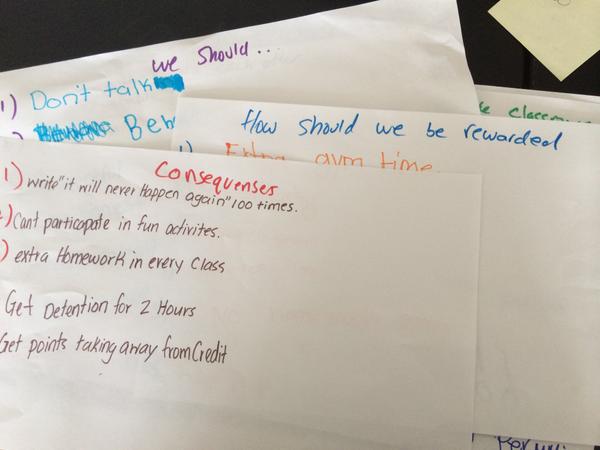After a long day of teaching general science to my 6th-grade students, I found myself sitting in a bar with two fellow black male educators. Throughout the evening of sharing drinks, recent stories and highlights of our lives, I noticed that our conversation constantly deviated from our lives to highlighting our common experiences as men of color teaching students of color in urban public schools. We all share a common narrative of what encouraged us to become educators. We want to influence and prepare the coming generations of urban youth for careers, higher education and encourage them to think critically.
As a college freshman, I desired to pursue a career in pharmacy and I would have never imagined that I would become an educator and work in a system that was responsible for my many negative experiences as a student in New York Public Schools. Like many educators of color, I took on this role as an educator with the goal of reinvesting in my community and its youth. My goal was to be a role model for students of color, someone they can authentically relate to.
As a student of New York City Public Schools, I only encountered three teachers of color from kindergarten to my senior year of high school. This racial disproportion among teachers which doesn’t reflect that of students has been largely documented. According to the U.S. Department of Education, about 50 percent of the public school student population is nonwhite, while 80 percent of public school teachers are white. School districts and policymakers have noticed this racial disproportion between students and teachers across the country and created initiatives to increase the number of teachers of color in public schools. For example, both Boston and New York City Departments of Education have initiatives focused solely on increasing the number teachers of color, in New York City specifically men of color.
The idea is if we increase the number of teachers of color within public schools, these teachers of color will serve as positive role models for students and help resolve the problem of underachievement noted in urban youth populations, who are typically students of color. While I agree that public schools across the country would benefit from an increased number of teachers of color in public schools, I argue that only focusing on the recruitment, as opposed to retention and the experiences of teachers of color within public schools, can be counterproductive in increasing and retaining the number of teachers of color in public schools. A report from the Albert Shanker Institute shows that teachers of color are leaving the profession, as the number of teachers of color has declined over the last 10 years. New Orleans and Washington, D.C., saw the most significant declines at 24 percent and 28 percent.
While I love being an educator, reinvesting in my community and its youth, my role as a teacher of color is shaped by unique experiences which at times cause feelings of defeat and makes my job challenging and increasingly stressful. Rather than policymakers and school districts focusing solely on the recruitment of teachers of color it is important to understand the experiences of teachers of color with the goal of increasing retention of these teachers in public schools. I describe a few experiences that I have faced as a teacher of color in an urban public school to shed light on the experiences of teachers of color to provide a context for why so many teachers of color may be leaving the profession.
The Disciplinarian, not the Teacher
As an educator, I find myself dealing with student behavior and conflict numerous times throughout the day. Oftentimes, my White colleagues seek my help in dealing with student misbehavior rather than my advice in regards to teaching and learning. On numerous occasions, I have been called to manage a students’ behavior while I was teaching because other teachers felt that I had a better rapport with students. Incidentally, students from across the school seek my counsel in improving relationships between them and their teachers. While I enjoy serving as an outlet for students, my primary role, and intent as an educator is not to be a disciplinarian. I believe that it removes me from my primary task of teaching. It also adds to my responsibilities as an educator. In all schools, it is every staff member’s responsibility to develop relationships with students and create equitable systems of discipline for all students.
Checking Teachers on Their Biases
Everyone, including myself, carries implicit biases that may change how we interact with others. Studies demonstrate that teachers have biases toward students, especially urban students, which often result in disproportionate suspension and expulsion rates of students of color as compared to their less diverse counterparts. In my experience in public schools, I notice many educators implementing harsh disciplinary action toward students of color and pushing for suspensions, without having conversations regarding behavior or trying to understand what experience caused that student’s misbehavior. Furthermore, I have noticed once teachers have labeled a student as having a behavior issue, that student will not have an opportunity to show their future teachers they can be anything else because they will be perceived by all teachers as the student with behavior issues. Part of our job as educators is to rid ourselves of biases as it relates to our students by gaining an authentic understanding of their realities and as a teacher of color, I feel obligated to check other teachers on their biases and disciplinary actions toward students.
Martyr for Urban Youth
As an educator of color, it’s important to understand that we can be impactful everywhere and in any context. We must not limit ourselves to teaching solely in urban communities, therefore being martyrs for urban youth. While teaching in an urban public school brings me great joy, I am pursuing a doctorate in Science Education with the goal of improving the education of urban youth on a larger scale. While I do not intend to be a classroom teacher for my entire career, fellow colleagues and administrators have suggested that I should remain a teacher because of my impact within my school. While I note my impact on the youth in my school, it important that we empower teachers of color to also move up within the ranks of education or other professions where they can aid and support the achievement of urban youth.
Ultimately, I thoroughly enjoy my role as an educator in urban public schools. But as much as I love my role as an educator, it is important to recognize that my unique experiences as an educator of color causes an increased amount of stress and adds to my daily responsibilities. Overall, I truly believe that it is important for educators, researchers, policymakers and school administrators to take a closer look at the experiences of teachers of color, and recognize that their experiences may be vastly different as compared to their white colleagues.








